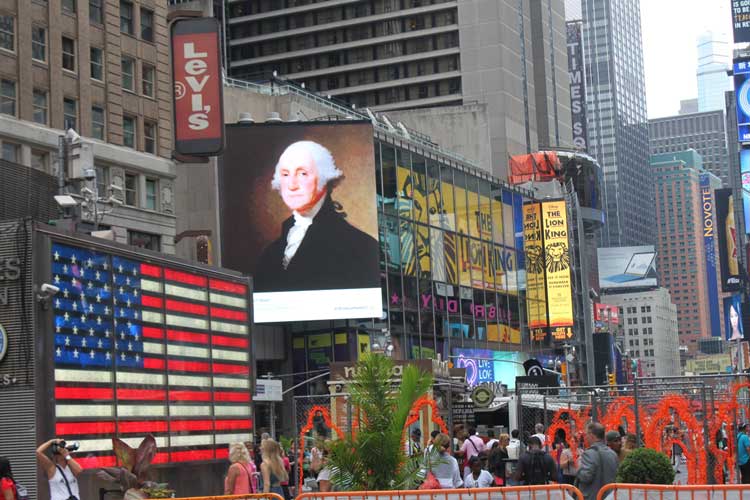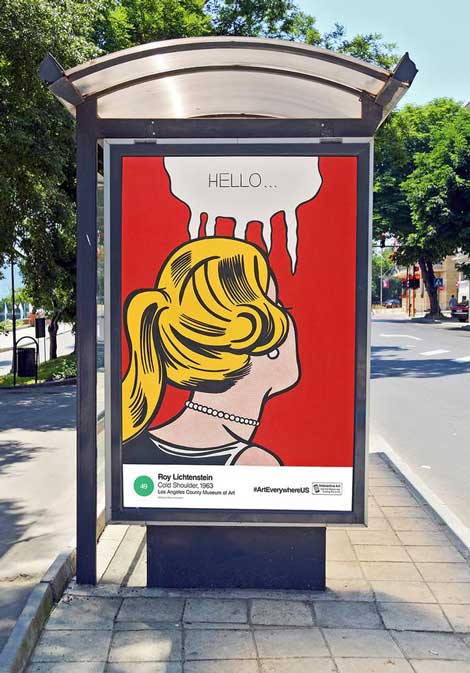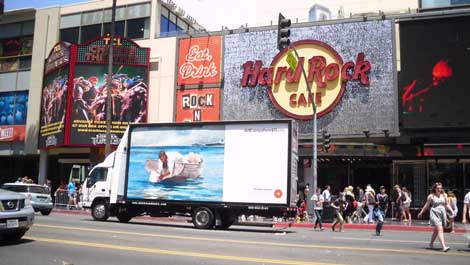If you have been in any number of major cities this summer across the U.S., you might have seen a billboard with the hashtag caption #ArtEveryWhere alongside a reproduction of a famous work of art. According to the tagline on the #ArtEveryWhereUS website, this is “A Very Very Big Art Exhibition.” Apparently, what looks to the uneducated eye like lackluster museum advertisements are actually art: real highbrow stuff being exhibited right there on the streets!
But of course, it isn’t. These are just further reproductions of famous works in a world already awash with reproductions. What’s worse, by framing a reproduction with a bunch of white space and a reference to the “lending” institution makes it, unambiguously, an advertisement. This is fine, museum ads are nice enough but the idea that this is “art” and therefore some kind of populist act of institutional beneficence grates: “Bringing art to the masses!” It smacks of disingenuousness, categorical confusions, glib opportunism, self-serving “charity,” mawkish viral marketing, curatorial overreach and cultural condescension.
That is, it seems that #ArtEverywhereUs wants to be regarded as art without relinquishing the concerns of advertising: the assertion of a particular corporate brand identity. In this case, the museums lending the works under the umbrella of the #ArtEverywhere “brand.” The propagation of reproductions works of art without the contextualizing information —the #ArtEveryWhereUS tag— would be closer in spirit to what we want from “art.” This attempt at branding reproduced works is annoying in the same way that TV station logos shown in the corner of the screen during the shows are irritating. It calls to mind what David Lynch has said about product placement, “Bullshit. That’s how I feel. Total Fucking Bullshit.” Or as the case may be: #TotalFuckingBullshit.
In a world of mass media where the lines between social media, advertising, entertainment, and art are constantly being blurred it seems reasonable that we would expect this kind of thing. Maybe we could acknowledge that it is a mixed bag and appreciate it without questioning its motivations. Maybe. But shouldn’t art institutions be held to a higher standard? Instead of participating in this blurring of lines they could be supporting projects that highlight or explore this blurring consciously.
In fact, there is a fairly rich tradition of art that has done this: offered us art in the spaces typically reserved for advertising in ways that undermine our expectations of those spaces. Some of these, by eschewing explanatory texts and taglines and the traditional language of advertising create a real sense of displacement and show us radical new uses for these sites. Felix Gonzalez-Torres famously made billboards of rumpled beds that were put up along stretches of lonesome highway. The insertion of images—of intimate yet vacant spaces—was a subtle, poetic, and politically charged intrusion of art into a space that is public but, also, quite private: alone in your car. #ArtEveryWhereUS does none of that. It asserts the validity of all the conventional categories (art is “masterpieces” from museums) and demands credit for subtly tweaking them, however provisionally, outside their “normal” context—as if this were a subversive or charitable act. As if we all need a little culture sprinkled down to us from on high. Thanks but no thanks.




